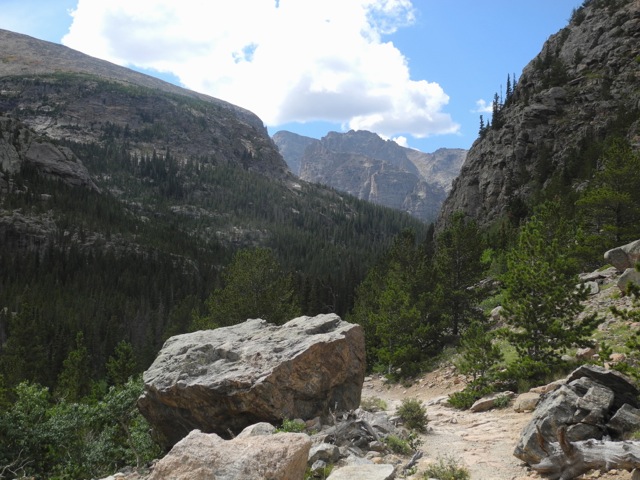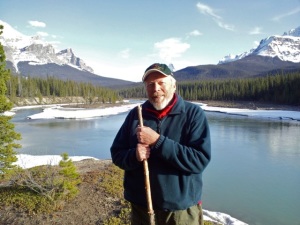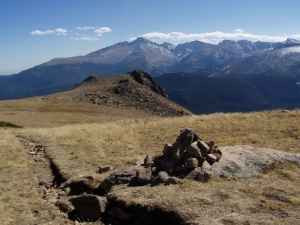
Rocky Mountain National Park, Glacier Gorge. Elevation at Trailhead 9,240 ft. Photo by M. Arloski
Whether it’s a trek in the Alps or a time to be “Rocky Mountain High”, getting up in the mountains is a great way to be well physically, mentally and spiritually. Being well at higher altitude however requires some important knowledge and sometimes, some caution. The people a wellness coach works with may face some challenges at higher elevation, especially if they are dealing with health challenges to begin with.
Gaining elevation quickly is easy in a place like my home state of Colorado. Say you start your day in Fort Collins where, like Denver we are basically a “mile high” (5,003 ft.). Off you go to Estes Park (7,522 ft.) and suddenly you have experienced an elevation gain of 2,519 feet. Drive into Rocky Mountain National Park and up to Bear Lake (9,450 ft.) for a hike and now you’ve risen 4,447 feet. All the trails from there only go up and you could easily exceed 10,000 feet in altitude as you enjoy the stunning beauty of the area. Top it off later with a ride to the peak of Trail Ridge Road (12,183 ft.) and now you’ve attained 7,180 feet (2,188 meters) in elevation gain. That gain itself is higher than any mountain east of the Mississippi.
When we experience how different it is to walk uphill at these suddenly higher elevations we often blame our lack of conditioning. The reality is based in physics and the resultant effect on our own physiology. This is not a time for a “try harder” attitude, in fact continuing to push may just invite serious trouble.

In Banff National Park, Canada
Simply Less Oxygen
Here is the best explanation of why we experience less oxygen at higher elevation. “The pressure in the atmosphere decreases as you gain elevation. The percent of oxygen is actually the same at all altitudes, 21%; however, it is 21% of a smaller number as one goes higher. The barometric pressure at sea level is 760 mmHg, and at 10,000 ft, it is 534 mmHg. Breathing the air of Telluride (Colorado) is the equivalent to breathing air with only 15% oxygen at sea level, instead of 21%. The net result is that there is 29% less oxygen in the air at Telluride compared with sea level. At 14,000 ft, the air has 43% less oxygen than at sea level. Because of the reduced air pressure at high altitude, the volume of air you breathe into you lungs contains less oxygen molecules in each breath.” http://www.altitudemedicine.org/index.php/altitude-medicine/altitude-physiology.
There are two main things to be concerned about at altitude: Acute Mountain Sickness (AMS) and your current state of health, especially looking at preexisting health conditions. AMS can affect people with symptoms at elevations as low as 6,500 feet, but usually we start to see greater occurrence when we exceed 8,000 feet. The Institute for Altitude Medicine (IAM) in Telluride, CO is an excellent resource for learning about AMS or altitude sickness. “One survey done at a Colorado ski resort at 9,800 ft. found that 60% of visitors developed a headache, the first sign of AMS, and also called high altitude headache. To meet the definition of AMS, other symptoms need to develop, such as loss of appetite, sometimes vomiting, weakness, dizziness, fatigue, and difficulty sleeping. AMS feels exactly like a bad hangover.” (http://www.altitudemedicine.org. )
Preventing AMS is all about a slow ascent and adequate hydration. Treatment strategies depend upon severity but the first step is “go no higher”, rest, hydrate and consider immediate descent if there is no improvement. See the I.A.M. website and learn detailed information.
Preexisting Conditions And High Altitude

Rocky Mtn. N.P. The Ute Trail- elevation 11,466 ft. Photo by M. Arloski
According to Peter Hackett, M.D., the director of I.A.M., experience at higher elevations can sometimes “unmask” preexisting health conditions that the person was not aware of. Struggling with breath and heart rate, feeling exhausted, can sometimes reveal heart and/or lung disease and is a red flag to get in to see your physician as soon as possible.
People with preexisting conditions such as high blood pressure, heart disease, valve disease, heart failure, heart arrhythmias, diabetes, Sickle Cell disease, and other conditions should know that higher altitude could aggravate their conditions. It is also important to know the effects of the medications you might be taking. For example, metoprolol, a beta-blocker, acts as a governor on your heart, preventing excessive heart rate, and thus inhibiting your athletic performance. This means being incredibly patient with yourself and allowing for more breaks when you are hiking uphill, skiing, etc.
Dr. Hackett says that while living at higher elevations can actually help some conditions (we develop more capillaries, asthma can be easier due to cleaner air, etc.) people with COPD and various lung diseases fair worse as they have difficulty transporting oxygen to the lungs.
The “High Country” does not have to be off limits to you, but knowledge about how altitude affects your condition, your medications, and what to do to make adjustments is vital. Again, the I.A.M. website is a treasure house of information. Enjoy the mountains and all their majesty, just do it wisely and well.
 The Coach’s Take Away
The Coach’s Take Away
A key part of any coaching Foundation Session is getting to know where your client lives and what their lifestyle is like. Your telephonic client may live in a very different world from the one outside your door. If you discover that they live at or near higher elevation, or they visit such places on skiing or outdoors vacations then helping them understand and deal with “altitude wellness” could be vital.
Being in great physical condition does not make one immune to AMS. In fact it has no correlation whatsoever. The especially fit client may want to maintain their sea-level workout routines or push themselves past wise limits physically as they play in the mountains. They need to play by the rules of elevation gain and energy output like everyone else. There is simply less oxygen available to those well-toned muscles at higher altitude and performance goes down.
The standard wisdom is to gain a thousand feet of elevation a day and build in plenty of rest. Hydration is vital as we produce more red blood cells to absorb the decreasing amounts of oxygen available. This thickens the blood and our bodies steal water from all our cells to maintain proper viscosity. So, we get severely dehydrated if we don’t pound the water. (Again refer to the Altitude Medicine site for guidance.)
As wellness coaches work with clients with preexisting medical conditions this is perhaps the most important area to be aware that altitude often has a significant effect. Clients with diabetes may discover an increased insulin requirement. The Altitude Medicine institute recommends that “Only diabetics experienced with exercise and in good control should attempt vigorous exercise at high altitude.” Clients with high blood pressure, any type of heart condition or disease, anyone with lung disease, etc. can be vulnerable to the effects of high elevation. Coaches should help these clients become familiar with the information on the Preexisting Conditions page of the Altitude Medicine Website. http://www.altitudemedicine.org/index.php/altitude-medicine/preexisting-conditions
Wellness coaching clients may find that their medical condition and/or the medications related to these conditions limit their ability to exercise or do what they used to do. Experiencing these limitations can bring up lots of emotion. The person can feel angry, frustrated, and can even get in touch with grief over what they have lost due to their medical condition. This is where coaches can be the empathic source of support that helps the client process these feelings. Plug in what you know about grief, remembering that a loss of health is a loss. Help your client to grieve what is lost and emotionally move on. And, of course, if this yields greater grief than can be dealt with in coaching, make a good referral to a mental health professional.
A great way to begin with such a client is to inquire about their level of knowledge about both their health and the effects of higher altitude. If, like most folks, there is a lack of this specific information, ask if they could see the value in knowing more about it, then co-create a strategy and accountability for how they can go about finding out what they need to know to be healthy and well in the High Country.
-written by Michael Arloski, from his blog, Real Balance Wellness
